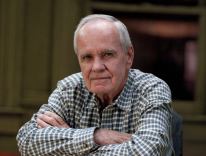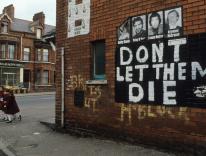Universal Father
A Life of John Paul II
Gary O’Connor
Bloomsbury, $24.95, 448 pp.
________________________________________________________________________
Published shortly before Pope John Paul II’s death, Universal Father is one of a raft of biographies of Karol Wojtyla. The most notable of the bunch is George Weigel’s Witness to Hope (HarperCollins), which had the advantage of both papal cooperation and exhaustive research. Weigel is still the person to go to for fact-checking, though less for interpretation, since there is a whiff of the hagiographical about it.
Gary O’Connor, a veteran biographer of theater personalities, has produced a solid, readable study of the late pope. He has a pleasing prose style and the ability to condense complex issues into a few pages. He spends a good deal of energy attempting to capture the pope’s “inner” life, particularly his universally recognized commitment to prayer. O’Connor’s tone is far more sympathetic than the muckraking assessment of his countryman John Cornwell (The Pontiff in Winter); O’Connor operates with the hermeneutics of trust rather than suspicion and is rightly dismissive of the more egregious judgments of the less than well-informed.
Because church history and theology are not O’Connor’s natural metier, he misses a number of nuances. It is not clear to me, as O’Connor baldly states, that the pope’s most important encyclical is Veritatis splendor. In my opinion, the most lasting one will be Ut unum sint, which addresses the issue of Petrine ministry. Also, a few factual errata slip into O’Connor’s text: Cardinal John Krol was from Philadelphia not Chicago; Edward Schillebeeckx never lost his license to teach as a Catholic theologian.
Borrowing an idea from W. H. Auden, O’Connor tries to fit the pope into the famous distinction between the genius and the apostle-not realizing that Auden borrowed that very distinction from Kierkegaard. For Kierkegaard, one could either be an apostle or a genius, not both. My hunch is that John Paul was more Kierkegaard’s apostle than his genius.
I read Universal Father before John Paul died. Rereading it again recently, I concluded that it does not catch the enormous significance of the life of the late pope. Msgr. Lorenzo Albacete has said that since John Paul was an actor in his youth, we should think of his papacy as a drama: the curtain has fallen and now we must await the reviews. Albacete’s conceit is an apt one; O’Connor’s book, like all John Paul II biographies thus far, is provisional. Only the distance of time will indicate how we are to judge the legacy of this extraordinary person.
________________________________________________________________________
Plan B
Further Thoughts on Faith
Anne Lamott
Riverhead Books, $24.95, 336 pp.
________________________________________________________________________
At a West Coast airport some years ago, I was desperate for something to read so I picked a book called Traveling Mercies. That serendipitous choice has made me a huge fan of Anne Lamott’s. I have since read all of her nonfiction (she also writes novels). Plan B, culled from her writings for Salon.com, is a delight.
Lamott is a deeply Christian writer who manages never to sound pious. She found faith after a series of addictions and failed relationships. A single mother of an adolescent son (whose rearing is hilariously and touchingly described in this book), she found a Christian church that provided her a spiritual home. Her credo is considerably shorter than the one composed at Nicea: “I don’t know much about God; only that he or she is love and not American or male. I do love Jesus and I’m nuts about his mother....You are not supposed to love Mary so much, if you’re not Catholic, but I do.”
These essays address Lamott’s struggles to raise her son as he navigates his teen years (“In biblical times they used to stone a few thirteen year olds with some regularity...the mothers were usually in the first row of stone throwers”); the death of a beloved dog; the disposal of her mother’s ashes; teaching writing at San Quentin; making connections to the father of her son; the travails of turning fifty (“I often feel like someone from the Book of Lamentations”); and her determination to connect her faith to social activism. We meet her friends: the Jesuit priest who, like her, struggled with alcoholism and whose faith is an inspiration; the people at her church; and the people she admires, such as Bette Midler, who described heaven as the place where people no longer talk about their weight.
Lamott is a Bay Area native who wears dreadlocks (one of her Sunday school kids called her “octopus head”), and has all of the political tics associated with Marin County. She is passionately anti-war, loathes George W. Bush, and practices “prone yoga”-“you just lay around as much as possible. You could read, listen to music, you could space out or sleep. But you had to be lying down. Maintaining the prone.” She is also, importantly, a devoted Christian-the only one her editor at Salon can stand, she reports. High praise.
It is a curious but true fact that some of the best spiritual writers of our day are women who are Catholic (Patricia Hampl, Nancy Mairs), Catholic fellow-travelers (Kathleen Norris), or, like Presbyterian Lamott, lovers of the Virgin Mary who seek spiritual guidance from a Birkenstock-wearing Jesuit. They all write brilliantly, they are intellectually fearless, and they are persons of deep faith. Here is an impossible thought: Why not commission the lot of them to write a catechism for young people? Add the poet Mary Oliver to the mix. Such a book would be idiosyncratic but, I suspect, young people would actually read it.
________________________________________________________________________
The Works of Mercy
James Keenan, SJ
Rowman & Littlefield, $14.95, 118 pp.
________________________________________________________________________
James Keenan has already written books on the commandments and the virtues for this series, which is edited by Karen Sue Smith of Church magazine. His third volume, compiled from essays that first appeared in that magazine, focuses on the corporal and spiritual works of mercy. Mercy, Keenan argues, is what makes Christian morality different from other ethical systems. His definition of mercy is original and powerful: a willingness to enter into the chaos of others.
Catholics have an old tradition of listing seven corporal and seven spiritual works of mercy. The number is not meant to be taken literally; rather, it is symbolic. As Keenan points out, Augustine was one of the first to write that spiritual care was as important as temporal care. To the corporal works of mercy he added consoling the afflicted, showing the way to the lost, and assisting those who hesitate.
Keenan devotes a chapter to each of the works of mercy and, in the case of the corporal works, shows how each has developed. He notes, to cite an example, that there is an ancient lineage that links the work of Catholic Relief Services to much older groups that did similar work. These chapters serve a number of needs: they provide a sense of the tradition; they show how charitable work is rooted in the gospel; and, finally, they challenge us to consider what needs to be done in our contemporary world. It was one thing to provide water for a village by sponsoring the town fountain; it is quite another to figure out how to provide clean drinking water to halt the thousands of deaths that occur every day from lack of this fundamental commodity.
In the last section of his book, Keenan has some quite wonderful pages on mercy and the Eucharist. Like some other moral theologians writing today, he is at pains to link action and contemplation, worship and morality. As he rightly notes, during Communion, we do not enter into God’s world; God enters into ours. This well-written and passionately argued book hits exactly the target for which it is intended: anyone interested in the pastoral life of the church. Keenan, to borrow a chapter title from his book, calls each of us to be a “minister of mercy” and gives compelling reasons why we should respond to that call.
________________________________________________________________________
Cross-Shattered Christ
Meditations on the Seven Last Words
Stanley Hauerwas
Brazos, $14.99, 108 pp.
________________________________________________________________________
Catholics of a certain age will remember the Tre Ore devotions of Good Friday, which featured seven sermons on the traditional seven last words of Jesus. I remember sitting in my un-air-conditioned church in Florida with my parents, listening to some leather-lunged missionary priest deliver the sermons, wondering if the service would ever end.
Devotion to the Seven Last Words is a relatively recent development in Christian piety. Both Haydn and Beethoven set the words to music in the early nineteenth century; by the time of the Second Vatican Council, a number of books had been published on the topic. After the council, however, interest in this devotion diminished with the institution of the Good Friday service. Curiously enough, devotion to the Seven Last Words has recently become popular again. Richard John Neuhaus published a reflection on the words in 2000, and Timothy Radcliffe, former master of the Dominicans, did so in 2005. A series of meditations (by Andrew Greeley and Martin Marty, among others) designed to be read along with Haydn’s music has also been published. These books are all, in their own way, proof that the biblical texts have a “surplus of meaning.”
As with most of the New Testament, there are echoes of the revelation given to the chosen people in almost all of the seven final statements. When Jesus says “I thirst” it is clear that the cry of Jesus must be, simultaneously, seen against Psalm 22 (“my mouth is dried up like a potsherd...”) and John’s emphasis on Christ as the Living Water. I say “simultaneously” because the gospel passage concerning Jesus’ thirst is not just a metaphor: it describes the real thirst of a dying person. To forget that is to risk slipping into Docetism.
During Lent this year I read Stanley Hauerwas’s Cross-Shattered Christ, which is based on a series of sermons he gave. It is a slight book; none of the meditations run more than a dozen pages, but they are packed with good theology. Hauerwas notes, for example, that when Jesus says “it is finished” (powerfully in the Vulgate: consummatum est), there is an echo of the Genesis creation account when, on the seventh day, God “finished” the divine work. I read Hauerwas’s book slowly and, in the process, discovered a number of new ways of thinking about the Passion narratives. This book would make good reading during the Lenten season, or a nice companion text for a retreat. An added advantage is handsome woodcuts by Rick Beerhorst, which aid the reader in experiencing what St. Ignatius calls in the Exercises, “composition of place.”
________________________________________________________________________
The Temple of Jerusalem
Simon Goldhill
Harvard University Press, $19.95., 208 pp.
________________________________________________________________________
The Temple of Jerusalem is one of a series of books on the world’s most important architectural monuments. (Another is Richard Jenkyn’s wonderful account of Westminster Abbey.) These books were originally published in England, and Harvard University Press has now made them available for readers on this side of the pond.
Simon Goldhill’s book is about the temple of Solomon, which was first destroyed centuries before the Bible was written. The Temple was rebuilt after the Babylonian exile and again during the reign of Herod the Great. It is this latter Temple that Jesus knew and that is featured in the New Testament. The memory of that Temple bulks large in Western history. To this day, pious Jews lament its destruction and pray at its Western wall. Ultrazealous Jews (abetted by fundamentalist Christians) scheme to rebuild it, while Muslims lay claim to the land where it stood. The Dome of the Rock and the Al-Aksa Mosque are both located on the Temple Mount. Orthodox Jews are forbidden to walk on the Mount for fear of treading on the Holy of Holies buried beneath.
The Temple has also served as a model and inspiration for Christians. Justinian’s architects claimed they outdid Solomon’s Temple when they erected Hagia Sophia in Constantinople. During the Crusader period, the Christians erected a cross over the Dome of the Rock, and artists such as Raphael and Bernini have sought to capture the temple’s former grandeur. (Bernini’s baldachino in St. Peter’s was supposedly inspired in part by the temple’s columns.) The mythos of the Temple even found its way into the rituals of the Freemasons, who have written (metaphorically) about “rebuilding the Temple.”
Since the nineteenth century, archaeologists have given us a clearer picture of what the second temple may have looked like. Of course, any attempt at a full-scale scientific excavation is out of the question due to the extraordinarily explosive character of Jewish-Muslim relations. After all, Ariel Sharon’s simple act of going up to the Mount triggered a second intifada, the fruits of which are still marked in bloodshed and violence.
What this book does make clear is that the temple of Solomon is more important for its memory than for its once existent reality. It is central to Jewish memory and piety and is woven into the theology of Christianity. Goldhill’s book is not a scholarly one, though it rests on reliable scholarship. I, for one, will bring the book to class next term to read Goldhill’s description of daily temple worship in Jesus’ time. The text is enhanced with some two dozen illustrations, and each chapter includes a reading guide.
Please email comments to [email protected] and join the conversation on our Facebook page.
Share
Previous Story
You Can Look It Up
Next Story
On the Sunlit Field


